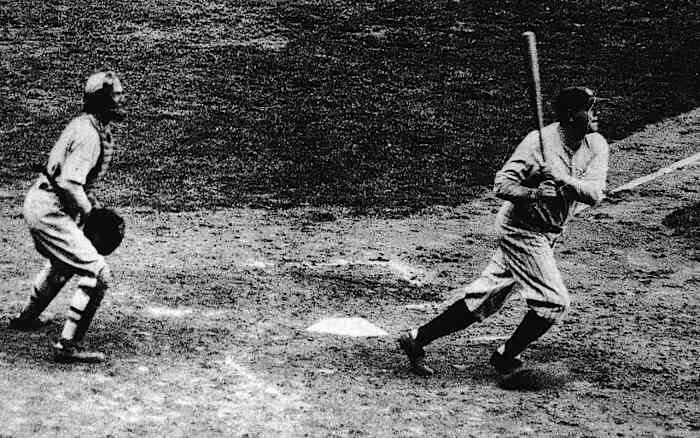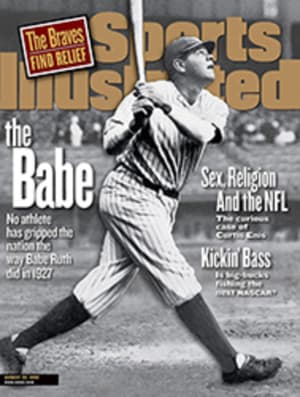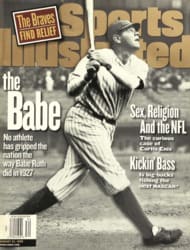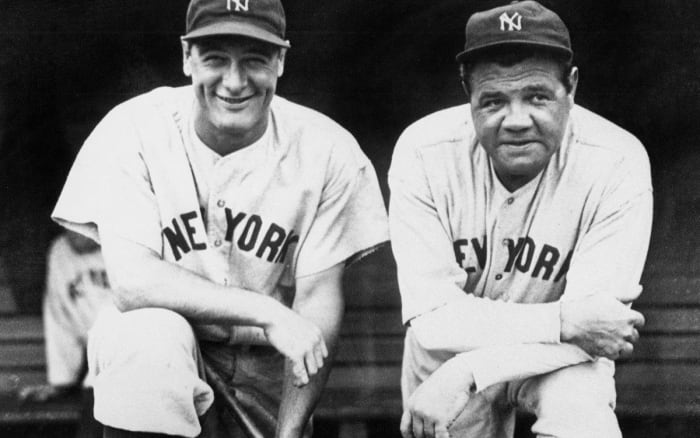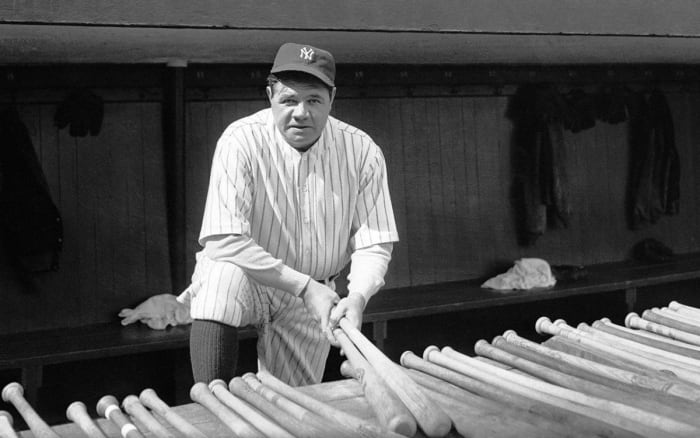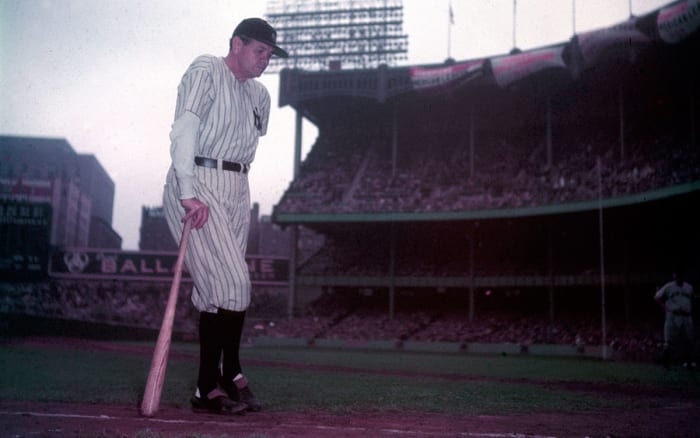The Colossus
At four in the afternoon on Sept. 29, 1927, in Yankee Stadium, Paul Hopkins got the call he had been waiting for since he was a boy. Bucky Harris, the manager of the Washington Senators, was walking to the mound and signaling for Hopkins to come in from the bullpen in leftfield.
Hopkins had just turned 23 and had never been in a major league game. Only four months before, he had been a star pitcher at Colgate, from which he had graduated in June, and he had pitched that summer for the New Haven Profs of the Eastern League. One day in early September, Hopkins got word that his contract had been sold to Washington for $25,000 and that the Senators wanted him to report at once. He held out for more money, but when the Senators threatened to suspend him, he made off by train for Washington. He had been working out with the team for nearly three weeks when Harris signaled for him by tapping his right arm.
Hopkins walked through a fading patch of leftfield sunlight to the mound. It was the bottom of the fifth inning. There were two outs. Hopkins looked around. The bases were loaded with Yankees: Walter Ruether on third, Earle Combs on second and Mark Koenig on first. Of all the things Hopkins remembers of that day more than 70 years ago, the one he remembers best is standing on the mound at the stadium called the House That Ruth Built and wondering who was coming to the plate.
Hopkins stole a glance toward home. There the batter was, looking bigger than the House itself, larger even than his myth: moonfaced and broad-backed and shaped like an inverted eggplant, dragging his bat toward the plate. No man on earth had more nicknames than George Herman Ruth. The Babe. The Man. The Bambino. The Home Run King. The Circuit Smasher. Herman the Great. Homeric Herman. The Bulky Monarch. The King of Clout. His Eminence. The Sultan of Swat. "I looked over and saw Ruth walking to the batter's box," Hopkins, 93, recalls. "I was a little nervous, but I wasn't scared. I always thought I could get anybody out."
The Babe, however, was on an incomparable tear. For more than five seasons, ever since he hit a major league record 59 home runs in 1921, he had been trying to surpass that mark. The closest he had come was 47, in '26, and by the beginning of the '27 season, when his hard-used, increasingly paunchy body had turned 32, his record looked out of reach. But in September, Ruth went on the most sustained spree of home run hitting that had ever been seen in one month. It began on Sept. 2, when he belted his 44th of the season, against the Philadelphia Athletics, and by Sept. 29 he had 14 homers for the month, more than the Cleveland Indians' starting lineup would have all year.
On Sept. 27, two days before Hopkins got the call, Ruth crushed number 57 against the A's, driving one of Lefty Grove's heaters like a golf shot into the rightfield bleachers for a grand slam. That left Ruth three shy of a new record, with three games to go. On Sept. 29, when Washington's submarine-ball specialist, Horace Lisenbee, tried to finesse a curveball past Ruth in the first inning, the Babe again lashed a drive into the rightfield seats. That was number 58. He was one dinger short of tying his mark.
Four innings later the six-foot, 175-pound Hopkins came in to face him. "It was like a dream come true," Hopkins says. "He was the greatest living ballplayer."
"The rookie looked at Ruth, and the Babe looked at the rookie," wrote Frank Getty in The Washington Daily News. "Ruth pawed the dirt of the batter's box. Then the rookie imitated the gesture, pawing the sawdust and the soil of the pitcher's box, and the duel was on."
Hopkins doesn't recall how many pitches he threw to Ruth in the fifth, but he had control of his curve and nibbled outside and in. He can still see Ruth ripping the ball foul down both lines. Twice the Babe swung from his spindly ankles and raised "monstrous fouls," as Hopkins puts it, into the seats behind him. "I thought I'd never get him out of there," he recalls. "I threw him nothing but curves, most of them slow."
The count was 3 and 2 when Hopkins delivered the slowest, prettiest snake that he had thrown Ruth yet. "A beautiful curve," he says. "Real slow and over the outside of the plate. It was so slow that Ruth started to swing and then hesitated, hitched on it and brought the bat back. And then he swung, breaking his wrists as he came through it. What a great eye he had! He hit it at the right second. Put everything behind it. I can still hear the crack of the bat. I can still see the swing."
The ball jumped off the bat, rising toward rightfield, growing smaller against the sky, and while Ruth started down to first, Hopkins turned and watched the ball on its long white climb toward the seats.
Babe Ruth died of cancer 50 years ago this week, on Aug. 16, 1948. More than 63 years have passed since he made his last appearance as a player, in a Boston Braves uniform, yet he remains the purest original ever to have played big league baseball. For all that he did in his 22 seasons in the majors, surely nothing left a deeper imprint on the game than the force and flair he brought to bear in striking the ball.
In the late teens of this century Ruth was the best lefthanded pitcher in the American League. As a member of the Boston Red Sox, he pitched 29 2/3 consecutive scoreless innings in World Series play, a record until Whitey Ford broke it more than 40 years later. But Ruth's pitching feats are footnotes, gathering dust among his batting records.
The irony is that 1927 wasn't his most productive year. No player in history ever had a season like Ruth's in '21. In addition to his 59 homers, he batted .378 and led the league in runs (177), runs batted in (171) and walks (144, many of them intentional), and his colossal slugging percentage of .846 was just a tick behind his 1920 mark of .847, a record that still stands. Yet it's '27 that became Ruth's year, the enduring symbol of the man and his myth. By that season he had altered the balance of the game, raising the home run from its relatively modest role into baseball's most dramatic event and a significant force in determining the outcome of games.
Among American icons Ruth had only two rivals that year, and neither of them could hit a curveball. Charles Lindbergh became an object of national worship when, on May 20 and 21, he flew The Spirit of St. Louis solo and nonstop from New York to Paris. On May 22 Ruth lofted his 10th home run of the year, in Cleveland's League Park. Ruth's other rival for public adulation, former heavyweight champion Jack Dempsey, achieved national martyrdom on Sept. 22 when he lost the Long Count title fight to Gene Tunney at Chicago's Soldier Field. Earlier that day the Babe hit number 56 at Yankee Stadium.
Not everyone, of course, had a career year in 1927. In the Soviet Union, Leon Trotsky, the brilliant Bolshevik ideologue and orator, was engaged all summer in an acrimonious struggle for power with Josef Stalin; a Mississippi flood in April and a Missouri tornado in September killed hundreds of people and left thousands homeless; and in Boston, avowed anarchists Nicola Sacco and Bartolomeo Vanzetti, Italian immigrants convicted of murdering a paymaster and his guard during a $16,000 robbery in Massachusetts in 1920, were executed in the electric chair on Aug. 23. They were seen by many as victims of xenophobia exacerbated by fear of anarchy, and they had become a cause celebre for leftists, such as dancer Isadora Duncan, who believed Sacco and Vanzetti were innocent men denied a fair trial.
In the midst of these storms, the apolitical Babe minced happily around the bases. Everything he did in those days, from smoking cigars to smoking fastballs, smacked of hyperbole. He ate too much. He drank too much. He womanized to a fare-thee-well. And when he hit yet another of his titanic shots, the reporters covering his games wrote the prose of excess, as if nothing less could do justice to his swats. In journalism this was the age of alliteration. The Babe's homers were described variously as "the wicked wallop" and "soaring socks." Ruth and teammate Lou Gehrig were routinely called "the Babe and the Buster." Even Ruth caught the alliterative fever. He had three favorite bats in 1927: Black Betsy, the Titian-colored Beautiful Bella and the ash-blonde Big Bertha.
No one, except perhaps Ruth himself, had more fun at his games than the writers. On May 31, five days after Henry Ford's son Edsel drove the 15-millionth Model T off the assembly line, with his father riding shotgun, Ruth hit homer number 15 in the first game of a doubleheader in Philadelphia and number 16 in game two. The second blow flew over Ty Cobb in rightfield and out of Shibe Park. Wrote James C. Isaminger in The Philadelphia Inquirer, "Ruth's crack in the second game traveled to the roof of a dwelling on 20th Street and then vanished toward the Jersey seacoast. It was a whale."
By then the word Ruthian had slipped into the sporting argot to describe things prodigious. Reporting on New York leftfielder Bob Meusel's Sept. 16 homer against the Chicago White Sox in Yankee Stadium, William Hennigan wrote in The World of New York, "His Ruthian smash in the fifth was a terrific clout to deep left centre field."
Unlike in 1920, when the Babe was just making his name as a power hitter, in '27 he was the Show. His home run quest was a one-ring traveling circus, the merriest entertainment in sport, a fitting accompaniment to Lindbergh's triumphant ticker-tape tour of American cities, during which millions jammed the rooftops and streets from New York to Boston to Chicago to celebrate the flight of the Lone Eagle.
Ruth hit home runs in every American League park that year, from Fenway in Boston to Sportman's in St. Louis; in fact, he had more home runs on the road (32) than he had at home (28). Of the 160 men who pitched in the American League that year, Ruth homered off 33 (23 righties and 10 lefties) and lit up 16 at least twice. He hit four dingers each off curveball artist Rube Walberg of the A's and forkball pitcher Milt Gaston of the St. Louis Browns; three each off seven others, including Tom Zachary of the Senators; and two each off seven more, including his old friend Howard Ehmke of the A's.
What to make of all the pitchers the Babe took downtown? The 33 arms ranged in quality from rich to raw to raggedy. Only two of Ruth's victims won 20 games in 1927: Grove (20-13) and the White Sox's Ted Lyons (22-14), both eventual Hall of Famers. Only 14 of those pitchers ended the season with winning records, and only two finished the year with earned run averages of less than 3.00: Lyons (2.84) and his teammate Tommy Thomas (2.98). Ten others closed the year with ERAs between 3.00 and 4.00, including Grove (3.19), while the rest, 21 strong, came to season's end with ERAs that ran from the 4.01 of Cleveland's exceptional second-year man, Willis Hudlin (18-12), right up through the 6.56 of the Browns' hapless Ernie Wingard (2-13).
Ruth's reign of homers fell on the just and unjust alike. He had at least six dingers against every American League club, though he saved his most stinging punishment, 11 home runs, for his old team, the Red Sox, which had sold him to the Yankees in 1920.
Though a natural pull hitter, Ruth often went with the pitch; so while he knocked 39 of his homers over rightfield fences, he hit five to right center, eight to center, four to left center and four to left. One of them, his 27th of the season, didn't leave the yard.
That merry blast, against the Detroit Tigers at Navin Field on July 8, is the one Ray Kelly recalls most vividly among all the home runs he saw the Babe hit. Kelly was nine years old in 1927, and for six seasons--ever since Ruth had seen him playing ball with his dad off Riverside Drive in Manhattan--he had attended most Yankees games as Ruth's personal mascot, sitting in the dugout dressed in miniature pinstripes. "He always treated me like the son he never had," recalls Kelly, an 80-year-old retired corporate accountant. By '27 Kelly was making road trips with the Yankees, and on this July afternoon he was in the dugout in Detroit as Ruth strode to the plate in the second with two men on base.
Ruth stroked a hard line drive off righthander Don Hankins, and as he sprinted toward first, the ball hit the wall and ricocheted past centerfielder Henry Manush, a future Hall of Famer. Though Ruth was 6'2" and weighed 215 pounds, give or take 18 hot dogs and a pail of bootleg beer, he was relatively agile on the base paths. As he steamed toward third, the coach waved him on. Ruth scored standing up. "It was incredible," says Kelly. "He came back to the dugout huffing and puffing. The players all gathered around him, laughing and pounding him on the back. He sat down on the bench, laughing, and said, 'I hit an inside-the-park home run! I beat it out! Can you believe that?'"
Ruth's home run odyssey began at home on Good Friday, April 15, in the Yankees' fourth game of the year, when he hoisted one of Ehmke's slow hooks into the far rightfield seats. What was so striking about the rest of Ruth's season wasn't only the evenness of his performance (after hitting four home runs in April and 12 in May, he caught a cresting wave and stroked nine homers a month in June, July and August), but also the sumptuous sense of theater he brought to his mightiest bolts.
Such was the aura that surrounded him that it's hard, at times, to cull fiction from fact. In the May 31 New York Times, Harrison reported Ruth's 14th homer of the year and tacked this curiosity to the end of his story: "The Babe hit a baseball so hard in practice that he broke it in two."
From the daily prints he emerged like a character out of folklore, Bunyanesque in size and strength. On the frosty afternoon of May 11, facing Ernie Nevers in St. Louis, Ruth hit a homer to the left of the centerfield flagpole that was the longest ball hit to date in Sportsman's Park. Wrote Martin J. Haley of the St. Louis Globe-Democrat, "Homeric Herman careened the animated leather for a sky-scraping bull's eye into the distant center-field bleachers, the ball clattering up the icy seats at the point where the left-center and dead-center field sections conjoin." So went number 8.
On June 12 the lead story in the sports section of The New York Times bore this headline and subhead:
BABE HITS 2 MORE AS YANKS WIN, 6-4 LIFTS HIS SECOND LONGEST HOMER INTO CENTRE FIELD BLEACHERS AS 30,000 GASP
That pair of homers, numbers 19 and 20, helped sink Cleveland in New York, and the first traveled so far that Indians catcher Luke Sewell insisted on inspecting Ruth's bat. "Lemme see that club!" Sewell demanded. "Nobody could hit one like that without a slug of lead or something in the end." According to the Times, Sewell picked up the bat and "scrutinized the end of it, balanced it on one hand and even sniffed at [it]. Though he found nothing illegal, Mr. Sewell...shook his head skeptically."
That was Ruth's longest poke of the year in Yankee Stadium. Eleven days later he hit a rope in Boston that left the yard in right, sailed over a runway that divided the right- and centerfield bleachers, bounced across a vacant lot and smacked the wall of a garage. That was number 24.
On June 26 the Roaring Twenties truly came to Coney Island when the Cyclone roller coaster, the most hair-raising ride of the decade, made its maiden run: a 110-second primal scream that swept passengers up and down nine hills and around tilted curves. Ruth was on a ride of his own. In Washington on July 3 he crushed a home run into the far centerfield seats. It would be, for years to come, the longest clout ever seen at Griffith Stadium. "A titanic home run," says Kelly. He remembers the exuberance of the Washington fans as Ruth circled the bases. "I have never heard a crowd cheer the way they did that day," he says. "The Babe tipped his hat to the people in the stands."
The 21-year-old sports editor of The Washington Post, Shirley Povich, witnessed that shot, and he would wait nearly 30 years to see another like it at Griffith. "Mickey Mantle hit one farther than Ruth at Griffith," Povich said in February, four months before his death at age 92, "but that was in the 1950s. Ruth's went into the seats near centerfield. Mantle's homer bounced off the edge of a beer sign in left and went out of the park."
According to Povich, the most striking thing about Ruth at bat was not simply the power that he generated but also the beauty of his swing. "He made home run hitting look easy," Povich said. "There was no violence in the stroke. He put everything into it, but he never looked like he was extending himself. By the time he hit the ball, he had taken a long stride forward and had turned his shoulders and ass and wrists into it, swinging through it. Exquisite timing. I can close my eyes and not only still see the swing but still admire it."
On Aug. 16 in Chicago, in the middle of what Richards Vidmer of The New York Times called an otherwise "dull and dreary afternoon at Comiskey Park," Ruth turned his scowlike beam into one of Tommy Thomas's fastballs and pounded it high toward right. "Upward and onward it soared in the general direction of the stockyards," Vidmer wrote, and "the last seen of it, it was sailing serenely over the roof of the double-decked stands with never a hint of slowing up."
Sam P. Hall, of the Chicago Herald and Examiner, wrote that the ball landed on a soccer field and that it was the first hit out of the park since Charles Comiskey had the place remodeled before the '27 season. "The stand is 360 feet away and about 80 feet high," wrote Hall. "The architect that made the improvements told Mr. Comiskey that no ball would ever be propelled out of his park. Well, the Babe did it and laughed like a school kid when he saw where it went." That was number 37. After the game, thousands of boys swarmed onto the field and milled around Ruth, patting him on the back, and it took him five minutes to get to the dugout, even with a police escort.
He didn't waver in the August heat. He had his first homer of the month on the 5th, and by the time the baseball season rolled into September, he had 43 home runs. He was hitting dingers harder and at a faster pace than he had at any time in his previous five seasons.
Both on and off the field, Ruth's circumstances were far more favorable than they had ever been. For years he had lived to defy authority, particularly that of Yankees manager Miller Huggins, but Huggins had brought Ruth to heel during the 1925 season by fining him $5,000 and keeping him out of the lineup for nine days. In 1927 the Babe still overindulged in food, drink and willing women, but not as much as he had in early '25, when his debaucheries caused him to collapse and nearly die. His first wife, Helen, whom he had married in 1914, when she was 16, left him in '26, after Ruth had taken up with a whip-cracking artist's model named Claire Hodgson. He loved her like the mother he had never really had. With Huggins fathering him on the field and Hodgson mothering him beyond the lines, Ruth had two powerful allies setting boundaries in his life.
"He was unfettered now," says Robert Creamer, the author of Babe: The Legend Comes to Life, the definitive biography of Ruth. "All of a sudden his life got solved a little bit. He accepted two authority figures: Huggins and Claire. It gave him a base. He was rid of all those things that had been bothering him, and he just played ball."
Ruth also had a player hitting behind him who had suddenly come of age and begun hitting homers with near-Ruthian regularity: Lou Gehrig. For most of the 1926 season Gehrig hit third while Ruth batted cleanup, but that September, Huggins fiddled with the lineup, moving Ruth to third and Gehrig to fourth. Through most of the '27 season, the Yankees lineup began like this: Combs, Koenig, Ruth, Gehrig, Meusel and Tony Lazzeri. This was Murderers' Row. With Gehrig hitting behind him, Ruth saw more strikes. And for the first time in his career, he was teamed with a genuine rival to his eminence as the Sultan of Swat--a fact that, Ruth admitted, spurred him on.
From the middle of April through early September, Ruth and Gehrig raced for the home run title. The 1927 Yankees are widely regarded as the greatest team ever assembled, and they won so often--an American League record 110 games--that at times the news stories focused less on the outcome of the games than on the chase within the games. On July 9, for instance, as the Yankees split a doubleheader with the Tigers, Ruth poked two homers, catching Gehrig with number 28 and passing him with number 29.
"The king is back on his throne again," Vidmer led his story in the Times. The paper had dubbed the Ruth-Gehrig race the Great American Home Run Derby. And The World began running a regular item called "Fence Busting Heat," which featured an illustration of a bulb thermometer with the number 59 (Ruth's '21 record) at the top. On either side of the thermometer were mug shots of Ruth and Gehrig above the number of home runs each had hit that year.
On Sept. 2, in Philadelphia, the Babe smote number 44, and Gehrig hit numbers 42 and 43. When they arrived at Fenway for a Sept. 6 doubleheader, they were even at 44 homers. Then, in the fifth inning of the first game, Gehrig took the lead by smashing a liner into the rightfield seats.
Whatever it is that lifts the level of a great player's game--pride or arrogance or some unfathomable form of genius--the Babe now drew upon it. Clif Keane was 15 years old, and he had cut school to go to Fenway and see his idol, Ruth. He was in centerfield when Ruth came to the plate in the sixth to face Tony Welzer. With the count 1 and 1, Welzer tried to slip a slow pitch past him, but Ruth caught it square. "I could see the ball leave his bat--very high and long into the centerfield seats," says Keane, 86, a retired baseball writer for The Boston Globe. "A tremendous drive."
"That was a long poke!" says Billy Rogell, 93, who was the Red Sox's third baseman that day. "We all just stood and watched it disappear."
"Ruth dealt the sphere a fearful blow, and it sailed far over the barrier in dead center, this being the longest distance from home plate," John Drebinger wrote in the Times. "All statisticians present were unanimous in declaring it to be the longest hit ever made at Fenway Park."
That was number 45. In the seventh inning Ruth hit his 46th off Welzer. The Yanks were winning in the eighth, 13-2, when reliever Bob Cremins saw Ruth coming to the plate. "I almost crapped in my pants," Cremins, 92, recalls. "Gosh, he looked so big." Cremins pitched in only four games in his big league career, all in 1927, but he treasures most the moment on Sept. 6 when Ruth bounced one of his pitches to first base. "I got Babe Ruth to ground out!" Cremins says.
But Ruth wasn't finished for the day. In the ninth inning of the second game he drove number 47 far into the rightfield bleachers. Nor was he finished with the Red Sox. The next day he cracked two more out of Fenway.
This performance seemed to paralyze Gehrig. He had only two more home runs the rest of the season, ending with 47. But Ruth appeared to draw energy from his five homers in two days. He was still five behind his record pace of 1921, and with 20 games remaining, all of them at home, he had to hit at least one ball out every other game to tie his mark. On the afternoon of Sept. 11, about 35,000 people went to Yankee Stadium to see Ruth perform against the Browns, and when he belted number 50, they sailed dozens of straw hats onto the field. "The coaches and the players had to join in helping to remove the hats," the Times reported.
Ruth was on a rampage. Two days later, in the seventh inning of the first game of a doubleheader, he stepped in against the Indians' Hudlin. "I'll tell you about Babe Ruth," says Hudlin, now 92. "During batting practice all the Cleveland players stopped what they were doing just to watch him hit. He's the only guy the players ever did that for."
Hudlin peered at Ruth in the batter's box. "His eyes were big," Hudlin says. "He had jack-o'-lantern eyes, and he'd hold that bat and look at you and put the chill in you." Hudlin tried to drop his best pitch, a sinkerball, past Ruth. "He swung from his heels, as he always did, and the ball just jumped off his bat," Hudlin recalls. "Never any doubt." The ball carried high and fell rattling into the rightfield seats. "His home runs went up forever," Hudlin says. That was number 51. In the second game Ruth dropped his 52nd home run not far from where the 51st had landed. Both dingers figured in 5-3 victories.
In the second half of September, Warner Brothers was finishing up filming the first major movie with sound, The Jazz Singer, starring Al Jolson. Ruth kept producing his own smash hits, though his life wasn't free of annoying distractions. On the morning of Sept. 16 he was standing before a magistrate in the West Side Court in Manhattan. An artist named Bernard Niemeyer was on the stand, waving a pencil and reading excitedly from his notes as he accused Ruth of having assaulted him on July 4 at the corner of 47th Street and Broadway. According to a story that appeared in The World, "Ruth, his huge frame enveloped in a neat brown suit, stood towering over his counsel, his arms folded and an expression of great solemnity on his countenance." The magistrate listened to the testimony and exonerated Ruth at once.
The triumphant slugger, shaking hands with dozens of fans, left the court and that afternoon went to Yankee Stadium, where New York won its 100th game of the season and Ruth banged his 53rd homer, into the rightfield seats. He had 12 games left to hit seven home runs and break the record.
It was a gathering celebration. Minutes after Ruth launched number 54, against Chicago on Sept. 18, the 10-year-old boy in possession of the ball jumped onto the field with ball and pen in hand and asked the Babe for an autograph. Ruth obliged, and the boy scampered off the grass to cheers. Nor was this the last of the joyful scenes that Ruth inspired in the final days of his chase. All of his last 11 homers went over the rightfield fence. There was number 55 on Sept. 21, against Detroit. On Sept. 22, the day of the Long Count, Ruth hit number 56, a game-winner. He carried his bat around the bases, and a youngster chased him from third to home, pounding on the Babe's back and holding onto the bat. "At last sight," the Times reported, "in a swirling crowd of other juveniles, the youngster was like the tail of a flying comet, holding onto the bat for dear life and being dragged into the dugout by the Babe, who raced to escape the rush."
Ruth was only three shy of a new record after he nailed that Grove fastball on Sept. 27. Then, after Lisenbee had served him number 58 in the first inning on Sept. 29, there was Hopkins turning to watch the ball's flight as Ruth sent that slow, fat curve toward right. "I thought it was just a big fly ball to the rightfielder," Hopkins says. Sam Rice drifted back to the wall. The ball floated over his head and into the seats a few rows back.
Ruth had finally done it. After six years he had tied his record. Fewer than 8,000 fans were at that game, but cheers tracked the Babe on his slow way around the bases. More hats sailed into the air. Handkerchiefs fluttered. "At the plate Lou Gehrig met him," wrote Ford Frick in the Evening Standard. "Miller Huggins was next, almost dancing his delight as he patted the big fellow on the back and led him to the dugout. And then all the rest--hopping about like kids, shrieking and yelling and shaking the hand of the greatest attraction baseball has ever known." Ruth had two games left to hit 60.
Hopkins was sitting in the Yankee Stadium visitors' dugout the next afternoon when Ruth came to the plate in the eighth inning. The Yanks and Senators were tied, 2-2, and Koenig was on third with a triple.
Gentle Tom Zachary, who had already given up two homers to Ruth during the season, was on the mound. Ruth had walked and singled twice off Zachary that day, and now he dug in again. He had hit number 59 with Black Betsy, says Kelly, but now he was waving the other black stick, Beautiful Bella. With the count 1 and 1, Zachary threw a screwball that broke down and in. Ruth swung and caught it flush, driving it on a hard line to right. It crashed into the bleachers, 15 rows from the top, and was fair by just six inches. "Foul ball!" Zachary protested, but umpire Bill Dineen, crouching on the foul line, had seen its line trace fair.
Pandemonium broke out in the crowd, and when Ruth lumbered to rightfield for the top of the ninth, he doffed his cap and smartly saluted the fans. His record homer won the game 4-2, and when he caught Walter Johnson's drive to end the game, Ruth was mobbed by fans who chased him and slapped his back as he made his way to the dugout. The party swept into the clubhouse, where, according to Creamer, Ruth bellowed, "Sixty, count 'em, 60! Let some other son of a bitch match that!" No one ever would in a 154-game season.
While Ruth's 1927 remains the best season of home run hitting in the annals of baseball, his performance that year was also the centerpiece of an even more remarkable feat of strength and skill: From '26 through '31, the Babe strung together six straight seasons in which he hit 46 or more homers. No other slugger has come remotely close to that. His 60th home run was the 416th of his career, and he still had nearly 300 more to hit. "Those six years were the most sustained stretch of great hitting by any batter," Creamer says. "It was astonishing."
Of the dozens of pitchers who threw to Ruth in 1927, only Hopkins, Hudlin and Cremins are alive. Together, they are 277 years old, and each owns a measure of fame for having thrown baseballs to the Babe. Hudlin pitched for 16 years in the big leagues, winning 158 games, but today he is remembered for two of the five shots he gave up to Ruth in nine years. There was the 51st in '27, "and I also gave up his 500th home run, on August 11, 1929," Hudlin says. "Another sinkerball."
Hopkins pitched only two years in the majors before arm problems forced him to retire, and he eventually went into banking in Connecticut. In 1995, when officials of the Babe Ruth Birthplace Foundation in Baltimore were preparing to unveil a statue of Ruth to celebrate the 100th anniversary of his birth, they discovered that Hopkins was still alive and invited him to the ceremonies outside Oriole Park at Camden Yards. He signed hundreds of autographs and was the subject of newspaper and magazine stories. Since the Ruth centennial, in fact, he has become a minor celebrity.
Hudlin gets about 25 letters a week requesting his autograph, and Hopkins says he may get 30 a week asking for his. "If I hadn't given up that home run to Ruth, you probably would have never heard of me," Hopkins says. "Sometimes you do something wrong and get rewarded for it."
After his cup of coffee with the Red Sox, Cremins returned to his home in Pelham, N.Y., where he served 38 years as the town's receiver of taxes. He too is sought out for his signature. "I was getting sick and tired of giving only my autograph, so I had these ballpoint pens made up," he says. Each bears this inscription: Bob Cremins pitched against Babe Ruth on Sept. 6th, 1927. He grounded out to first base. My autograph is worth 15 cents in the baseball memorabilia book.
After Ruth drove that curveball into the seats in right on Sept. 29, 1927, Hopkins struck out Gehrig to retire the side, walked back to the dugout, sat down on the bench and broke down and cried. "I couldn't get Ruth out," he said.
He thinks back on that and weeps no more. Hopkins wouldn't know it for many years, but that was the day the Babe made him a baseball immortal, a part of Ruth's own imperishable history.
